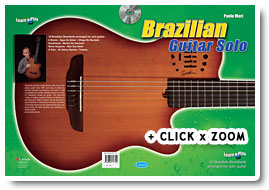VIDEO - Mas que nada watch...
AUDIO - Mas que nada.mp3
(included in the attached CD) listen...
SCORE - Mas que nada.pdf
(included in the book) watch...
This book contains the chord-melody arrangements of ten classical pieces of the Brazilian music, written for fingerstyle guitar.In chord melody the guitar is self-sufficient, carrying out by itself the tasks that are usually divided among a variety of instruments.
Music is essentially composed of three elements: melody, bass line, and harmony, all held together by rhythm, the “skeleton” without which everything would collapse. In chord-melody arrangements these elements are realized at the same time, keeping some fundamental points in mind:
- the melody is the fundamental “ingredient”, characterizing and distinguishing every musical piece, and it is therefore to be favoured, it is the element that should never be missing or left in background;
- the bass line is the “engine”, the foundation of the music; in the case of bossa nova, it is almost always executed on the downbeat, alternating the root (on the 1st and 3rd beat) and the fifth of the chord (on the 2nd and 4th beat). When the root is on the sixth string, it can be kept for the whole measure, avoiding the alternation with the fifth. An exception to this rule is found in the piece Maria Ninguem, where the bass plays a note on the upbeat in the last eight of every measure.
- the harmony (defined as comping) can be achieved in different ways:
a) to fill the gaps left by the melody (e.g. Desafinado); in these situations it is better not to use notes in the high range, so as not to “disturb” the singing;
b) to harmonize the notes of the melody, adding one or more of the lower notes of the chord (e.g. A banda);
c) to create an introduction (e.g. Só danço samba) or a coda (e.g. Tristeza).
Here are some more comments on the melody:
- a characteristic of bossa nova is that the melody is often executed with a little advance or delay with respect to the notation on the score; every performer must apply this concept according to his/her personal taste, and should listen to many versions of each song, in order to obtain an appropriate execution of the song itself;
- the melody is normally developed on the higher notes; an exception is found in the introduction of Mas que nada, where the lower notes carry out this function. In this case, the index and middle finger of the right hand play in the area that is normally for the thumb, that is, the three lower strings (fourth, fifth and sixth).
In choosing keys, I have favoured situations where open strings can facilitate the work of the guitarist: the pieces have thus been transcribed in D (A banda, Tristeza, Desafinado, O pato), E (So danço samba), G (Maria Ninguem), Em (Mas que nada), Am (Manha de carnaval), Bm (Agua de beber), Dm (Chega de saudade).
I recommend that you use an instrument with nylon strings, in order to obtain a “warmer” sound, which is more suitable for this style, also because the wider keyboard allows a cleaner execution.
I wish all my fellow guitarists a good study and enjoyment, in the fascinating world of Brazilian guitar!
